Hey Loungers,
Today we propose you a bit of a special episode of A Gem Dealer's Journal, as we will be discussing our latest trip to Madagascar. While the Hunt for Red October was already taken by Tom Clancy, we decided to go after Pink August which was conveniently more readily available in the area of Ilakaka.
For those of you that would like to learn more about Ilakaka and its surrounding we propose you to follow this link to an article by Vincent Pardieu while he was at the GIA Bangkok: read now.
Our merry group upon arrival at Le Relais de la Reine - Photo Credit: A nice chap!
Before we go any further with this article, we'd like to extend a big thank you to our Ilakaka based friends, Guillaume "Guji" Soubiraa and Mark Noveraz from Color Line, without whom none of it would have been possible and a gigantic thank you to the Lotus team, Richard Hughes, Billie Hughes and Wimon Manorotkul, to take us along for the ride as well as Julie Poli from Polichromos for being a fun travel companion!
Back on topic, our trip was a collaboration between our pals over at Lotus Gemology, Polichromos, Color Line Madagascar and yours truly and took place in early August 2019. The original aim of the trip was diverse, the Lotus team went in order to find more samples for their research collection while Julie, from Polichromos, and myself went in with a more gem dealing and touristy mentality.

Isalo National Park is located in the South West of the Red Island - Map Credit: Authentic Traveling
After a rather long trek across two continents and flight delays that'd make Colombus' trips look like a cake walk, we finally arrived to the Isalo National Park region where the mines and Ilakaka are located. The park is famous for its lemurs and for the wild treks that tourists seem to enjoy!
Right as we arrived, besides dropping the luggages and checking in at the gorgeous Relais de la Reine, famous for hosting passing gem merchants from around the world as well as regular travellers, we went with Guji to the gem market in Sakaviro.
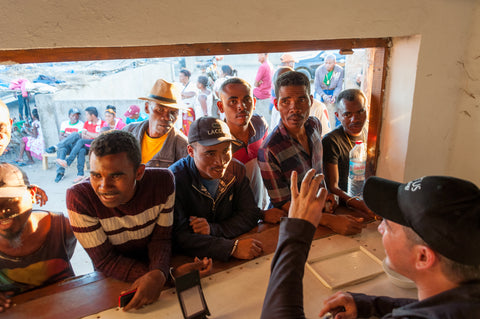
Here is ColorLine's "Guji" checking on sapphires from the local merchants in Sakaviro Gem Market - Madagascar - Photo Credit: AsiaLounges Co., Ltd
There, we dived directly into the fray and started to look for good photographic and business opportunities. The Sakaviro stop was our daily routine and indulged into it after every mining trips.
It is fun, colourful and occasionally nerve racking either because you can't get what you want or simply because you are fed synthetics by the load on a daily basis with the hope that you'd fall for it...
Fortunately, our team was toughened by lab expertise on one side and the hardened skin of daily gem dealing on the other so, we skilfully avoided all these tricks.
Fun fact about Sakaviro market, I personally saw nicer gems in the morning at Color Line as the merchants were coming to show their goods, mostly small merchandise (0.2 to a gram at best = 1-5 cts in the rough) than in the market in the afternoon. It boggles the mind but, as I like to say, it's not because you can find cheaper that it'll be better...

Here, at the breakfast table at ColorLine. On the left, you can see the type of gems I wish I'd seen at Sakaviro more often (1 grs ++), on the right what was more often seen (0.2 to 0.6grs) - Photo Credit: AsiaLounges
Sakaviro market is located about 15 to 30 minutes away from Ilakaka by car and is basically a street. A lively one, during market hours, or one that's about as quiet as a cemetery during the rest of the day.

Gem dealers and miners taking it easy in Sakaviro by the BBQ in front of ColorLine's booth - photo credit: AsiaLounges
In a rather amusing way, this charming little market reminded me of Chantaburi both in spirit and activity. You have entire families of dealers and miners going around the street discussing, munching on a piece of barbecued meat or drinking something as they go to their various occupations.
As such, much like one can witness in Asia, kids are helping the family with the local stalls upon returning from the school that's but a few kilometres away from the market as you can see in the following picture.

Kids helping their family in the market in Sakaviro - photo credit : AsiaLounges
About the market itself, another reason why it reminded me so much of Chantaburi is that one can meet the usual suspects there. Our fellow gem dealers from Sri Lanka, Thailand and a few passing Westerners can be seen snooping around. But again, much like it is the case here, the Sri Lankan and the Thais are everywhere and are literally holding the market in their hands, without them there'd be no trading and the majority of mining towns would likely not exist either.
The attentive eye can see advertising about their nearest purchasing offices near every mine and, truthfully, they can been seen virtually anywhere. From restaurant to village square, the phone numbers of these prominent dealers are everywhere!
This system allows them to keep the mines and their denizens fed and in working conditions while controlling the flow of goods by purchasing virtually everything that comes out of there leaving us with the crumbs.

One of our fellow Sri Lankan Dealer is anxiously looking for a good parcel to pop by - Photo Credit: AsiaLounges
While discussing about the market is no doubt of interest, I doubt that is what drove you to click on this article. So, let's move on to the few mines we visited after: Analasoa mine, Maromiandra mine, Swiss and World Banks and a cookie for the end: a cleaning point right on the outskirts of Sakaviro.
The first mine we visited was Analasoa, which is set, like most mines there, in the middle of nowhere and allowed for a nearby village to rise. This place is bordered by a river down below while the miners are digging holes in the sands of the Red Island!
The mine is rough, no pun intended, dusty and the first thing that comes to mind is: "how can they find anything in there?".
Honestly, if I had to keep but one thing from this trip, I'd say that it has been an eye opener on the mining conditions. How tough, uncomfortable and quite a bit ingrate too, the work there looks to be.

Here is a picture of Analasoa Mine, Madagascar - Photo Credit: AsiaLounges

Albeit the rather tough working conditions, people smile, they seem rather happy about what they find - Photo Credit: AsiaLounges

While others are looking for hope in the heavens - Photo Credit: AsiaLounges
No gems were ever presented to us at the mines. However, much like with the morning and evening markets, once we would stop for lunch under the shade of the one coffee stall present at the mining village, little bags would slowly make their way to our table followed by the distinctive voice of one of our mining friends saying : "Vaza! Regardes!". (T.N. : Foreigner! Look!)
From there, the baggies would come from all directions. Some containing rather pleasant surprises while others would be trying to pass a synthetic or two as a real deal.
We personally did not buy there, as we found nothing of interest, but I can see why tourists would, if only to bring back a fun souvenir from their mining trip.
Most of what was presented was small included material featuring a nice colour but, as it is usually the case at the mines, the prices where... touristy...

Miners walking to Maromiandra area as we were driving there - Photo Credit: AsiaLounges
The second mine we visited was Maromiandra. Heading there was a bit more of a journey than the first one.
We left early morning, remember I'm a gem dealer so, kicking out at 8 am is as natural to me than moonlighting might be to you...
We actually tried to go twice to this particular mine but were stopped during our first attempt as there were conflicts at the mine and our escort deemed it to be more prudent to fall back for the day.
Apparently, one of the pit fell on a miner and, to make things better, the mine owner and the village chief disagreed on the wages that were to be paid to the miners... It resulted in a logically explosive situation that was eventually resolved. Miners around the world are exposed to the exact same risks and, when the mines are not properly re-enforced, as it is sadly often the case in these areas, they tend to collapse, often leaving people trapped at the bottom of their pits...
Drove for a few hours in the middle of beautiful lunar landscapes until we finally reached our parking point. Previously, with Analasoa, the parking point was more or less where the mine stood but here, surprise! A good hour or two of trek was waiting for us and our Gendarmes escorts had a hard time not laughing at our desperate efforts at crossing the river without falling in face down.

Our Gendarmes escorts and driver discussing about our next course of action as Maromiandra appeared to be dangerous for the day - Photo Credit: AsiaLounges
Our second attempt was, as I mentioned earlier, more successful than the first. The trek too was, somewhat of journey. A fun few hours filled with surprising moments such as the main river crossing where people where bathing as Zebu carriages were passing by.
The, understandingly, surprised look of the people bathing as we went through their "bathroom" or the people cleaning the dishes and the rough that were visibly more amused than shocked to see us pass by. You'll excuse the lack of pictures of this arguably hilarious moment but, I felt a bit awkward intruding in these people's intimacy let alone taking pictures of it...
Anyhow, after this river crossing, we started our ascension to the mining area which I'd say was about 3 kilometres away from the river on top of a hill. We were again, gifted with stunning landscapes on the way. A surprisingly "large" village welcomed us on the way up as a groups of miners were coming from the opposite direction for their lunch break.

Here is Maromiandra Mine as we arrived to the top of the hill - Photo Credit: AsiaLounges
We reached the top of the hill and the mining field minutes later and, much like at the river, we became the attraction of the moment instantly. The miners were obviously as curious about us than we were about them. Since we had the camera advantage we could record the moment but they couldn't... As Borat would put it: it was "A Great Success!"
Guji decided to start his drone and, at that moment, any hope of taking picture of anyone mining vanished! They were, understandably so, much more interested by the flying machine than by getting any gems off the ground.

All but one of the miners were swayed by Guji's magic tricks - Photo Credit: AsiaLounges
We stayed there a couple of hours, talked to the miners and witnessed how entire families were living around the pits. All in all, it is a real ecosystem, a small community that has set up camp there!

Miners manning the mining pit at Maromiandra mine, Madagascar - Photo Credit: AsiaLounges

Miners checking up the potentially gem rich gravel they lifted up from the pit in Maromiandra, Madagascar - Photo Credit: AsiaLounges
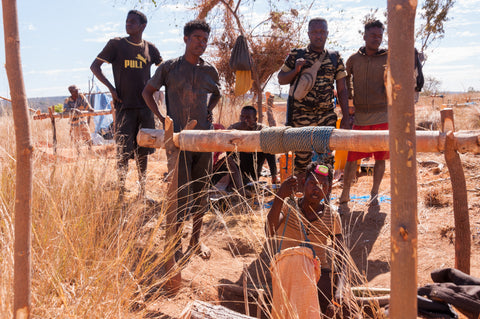
Who said only Alice would follow the Rabbit down the hole? - Photo Credit: AsiaLounges
While I have never seen kids working at the mine it is hard to say whether it exists or not but, quite frankly I do not think that it is the most pressing issue there either. The mining conditions themselves are hard enough as they stand. Miners have little to no understanding of how to strengthen the mining pits thus literally risking their lives every time they are going down...
I have been asking a lot of questions about ethics recently in the interviews but, upon seeing this, I'm wondering if we are not getting the whole fight wrong. Perhaps, the way forward would be to educate the miners to work in a more secure way? Would doing that maintain their lively hood as it is though? Would increasing the production price dramatically reduce their sales potential? One must wonder...
Fortunately, all isn't nearly as grim as these dark thoughts. The following day, we went to visit the closest mine of the three ton Ilakaka: the twin mines of Swiss Bank and World Bank.
Located a good 15 minutes from the centre of Ilakaka, these two mines also happen to be the play ground of the local junior rugby team. This team is the brain child of a local NGO called Rugby Saphir Association which aims at providing activities to the kids of the area. The trade is heavily investing in the growth of the area as one can witness by seeing the schools that have come up in the area as well as the brick walls of the building in the area as opposed to the more traditional straw build houses in the countryside.
We spend the morning witnessing the training of the kids in between the two gigantic mining areas which we'll visit later on that day.

The youngest part of the local Rugby team - Photo Credit: AsiaLounges
The kids seem to enjoy the game very much and were, as all kids should be, smiling, running around and, while most were fiercely competitive others were more... laid back. All in all, kids being kids!

Kids enjoying the game in Ilakaka - Photo Credit: AsiaLounges

Fun moments with the kids playing rugby in Ilakaka thanks to the Rugby Saphir Association - Photo Credit: AsiaLounges

Big or small matters not to these kids, what matters is the game - Photo Credit: AsiaLounges

And since I can already hear people telling me: "What about the girls" here they are, playing together with the guys :) - Photo Credit: AsiaLounges
We came back to these two mines in the afternoon to visit the actual mining pits. This time, there were no small rigs, no guys going down the tiny hole of the mining shaft. No! This time it was a gigantic crater, an open style pit somewhat similar to what can be seen back home. These mines opened in 1998 and have yet to stop producing gems. These pits are 25 to 35 meters deep depending on the where you stand in the mine and give birth to some very intriguing yet highly photogenic moments.
For example, that group of eight lads using their shovels in line and in rhythm. At first, I admit scratching my head as I was wondering if they were faking it or shooting the latest Mel Brooks movie... Turns out they were displacing dirt in order to allow for the actual production site to go deeper while the sides or old pits are recovered and left as they were found originally.
At first, I admit scratching my head as I was wondering if they were faking it or shooting the latest Mel Brooks movie... - Video Credit: AsiaLounges
The mine was quite frankly impressive and, once again, I have been wondering whether these places truly feed the trade with some of the nicest gems it has...
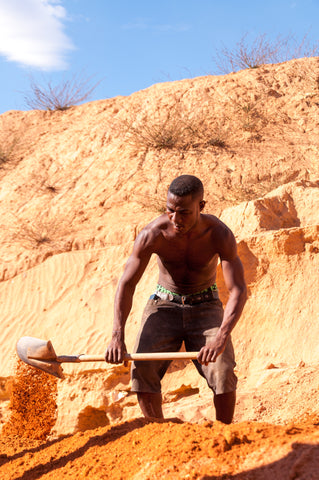
Miners of Ilakaka, Madagascar - Photo Credit: AsiaLounges

In the mines I have seen old and young men working but never have I seen kids digging - Photo Credit: AsiaLounges

The mine leader shouting orders to her team mates xD - Photo Credit: AsiaLounges in collaboration with Billie Hughes from Lotus Gemology and "Momo" from ColorLine Madagascar

It appears that one of the miner found a gem or has he... - Photo Credit: AsiaLounges
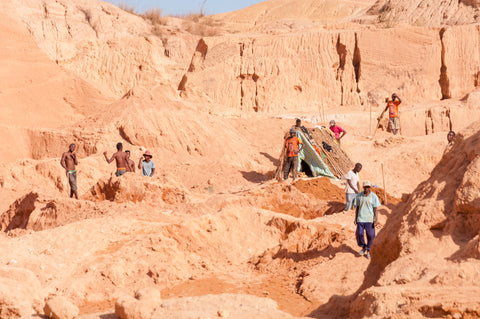
The PIT of World Bank, Ilakaka, Madagascar - Photo Credit: AsiaLounges
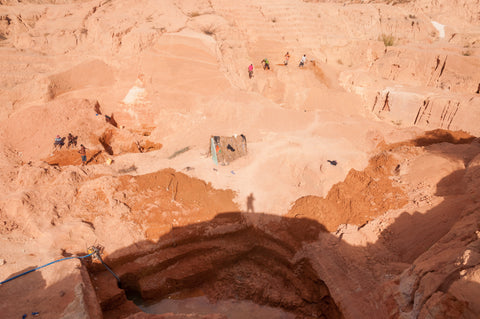
Quite the dive if seen from atop, World Bank, Ilakaka, Madagascar - Photo Credit: AsiaLounges
Now that we are done with the mining areas and shown you some of what we've seen there. It is important, I think, to show you what is done with the gem rich sands that are excavated. Time to show you, how gems are really found whether our mining friend above like it or not, it's not what he showed to the camera!
The cleaning point we visited was minutes away from the Sakaviro and attracted us more than once without ever managing to make us stop until the very last day of our trip.

Welcome to Sakavira Rough Cleaning point, Ilakaka, Madagascar - Photo Credit: AsiaLounges
This place, besides being blessed by an amazing light allowed us to see a cute little community of miners and mining families going to the river to check on their village's findings and hopefully find the grail.

Sieving though mud in hope ton find a gem - Photo Credit: AsiaLounges
Here, we saw bags after bags of potentially gem rich grovel that were turned upside down on the ground before being split on wooden sieves and washed in the river.

Checking on the gem rich grovel - Photo Credit: AsiaLounges
The adults were sieving or resting and the kids played around with hand made toys meant to imitate the tools of their parents as you can see in the following picture:
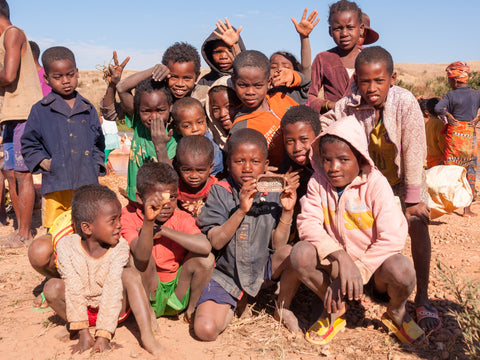
Kids playing by the river with tin cans they drilled in order to look like the tools of their parents - Photo Credit: AsiaLounges
We hope you enjoyed reading this article as much as we enjoyed travelling to Madagascar and writing this article upon our return. Should you have any comment or suggestion feel free to let us know either by commenting here or on your favourite social media platform or by mailing us at Simon@asialounges.com.
Should you wish to learn more about a particular topic or see an interview with a particular person, maybe even yourself, don't be shy and let us know! We work on your behalf so feel free to tell us what you want to read about!
For the rest, you know where to find us and where to find Our Creations as well as our Available Gems.
As per usual, if you liked what you've seen and read here, please like us on Facebook and Instagram and don't forget to share your favourite article to help spread the love of gems and jewellery.
If you want to support A Gem Dealer's Journal, here is a link to our Patreon's Page.
See you soon in the Lounges,

